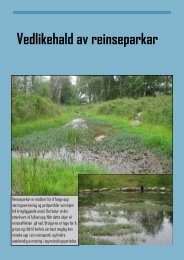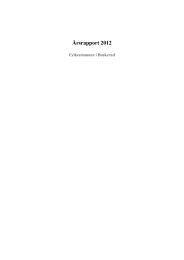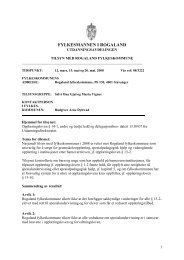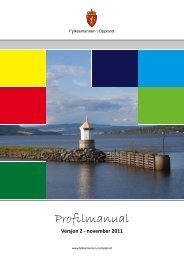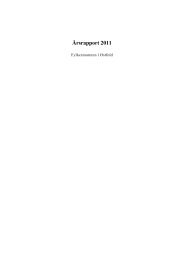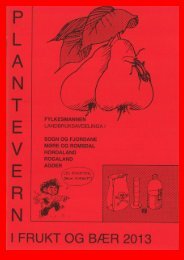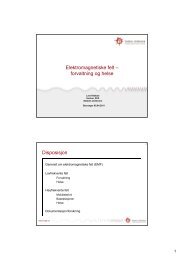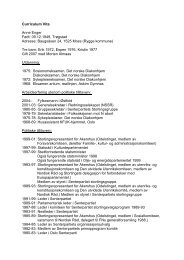Norsk svarteliste 2007
Last ned Norsk svarteliste 2007 - Artsdatabanken
Last ned Norsk svarteliste 2007 - Artsdatabanken
Create successful ePaper yourself
Turn your PDF publications into a flip-book with our unique Google optimized e-Paper software.
<strong>Norsk</strong> <strong>svarteliste</strong> <strong>2007</strong><br />
Risikovurdering Risk Analysis<br />
(Global Invasive Species Database, http://www.issg.<br />
org/database), iii) kriterier for kategoristatus <strong>2007</strong>, iv)<br />
en grov klassifisering av vektor (se boks 14), v) en grov<br />
klassifisering av spredningsvei (se boks 15) og vi) en<br />
grov klassifisering av livsmiljø som arten forekommer i<br />
Norge (se boks 16).<br />
Presentation of the risk analyses<br />
The results of the risk analyses are presented in a simplified<br />
form in this book. More detailed information on<br />
each risk-analysed species is available by performing a<br />
search in the Alien Species Database on the Norwegian<br />
Biodiversity Information Centre web site (www.Artsdatabanken.no).<br />
In addition to the scientific name of the species, the<br />
table of the risk-analysed alien species in Norway in<br />
<strong>2007</strong> contains: i) the Norwegian names of those species<br />
for which a reasonably unambiguous name exists, ii)<br />
whether the species is listed on the World Conservation<br />
Union (IUCN) list of the 100 worst invasive species in the<br />
world (Global Invasive Species Database, http://www.issg.<br />
org/database), iii) criteria for the category status in <strong>2007</strong>,<br />
Box 16. Broad classification of type of environment used in the table of riskanalysed<br />
alien species in Norway in <strong>2007</strong>. The classification follows Ødegaard et<br />
al. (2005):<br />
Fe Open fresh water – comprises habitats that are permanently, or for long periods, submerged, or where the actual water<br />
bodies form the habitat. It includes everything from large lakes to small tarns, as well as all types of running water.<br />
Fj Alpine and tundra – comprises mineral soil above the treeline, i.e. alpine ridges, early snow patch vegetation, late<br />
snow patch vegetation, tundra and patterned ground. Alpine mires are included in V and tarns are included in Fe.<br />
I Indoors – comprises all types of man-made constructions and natural caves.<br />
J Agricultural landscape – in addition to the pure agricultural landscape, this comprises cultural landscape with trees,<br />
anthropogenous grassland above and below the treeline, coastal heath, wasteland and sand and gravel pits. Farm<br />
ponds are included in Fe.<br />
K Coast and seashore – includes coastal habitats from the lower tidal limit to the salt-influenced area above the<br />
spring-tide level, inclusive. It also includes sand dunes close to the sea and sea cliffs (e.g. bird cliffs). Sublittoral<br />
vegetation that is permanently or almost permanently submerged is included in M.<br />
M Marine environment – comprises the littoral zone, sublittoral habitats, deep-sea habitats and pelagic environments.<br />
Ice-associated types of habitat and brackish water are also included.<br />
P Parasites and diseases – comprises host species for parasites and diseases.<br />
R Scree and rock vegetation, and gullies with streams – comprises dry, open grassland which is not, or is only slightly,<br />
anthropogenously disturbed, unstable unconsolidated deposits lacking closed vegetation, stable types of habitat above<br />
and below the treeline with a poorly developed vegetation cover and gullies with streams. Salt-influenced rocky<br />
shores are included in Coast and seashore.<br />
S Forest and woodland – comprises types of habitat where trees predominate, i.e. all types of woodland and forest,<br />
including clear-felled areas, afforested areas, upland birch woodland and wasteland with trees. Pastures with scattered<br />
trees, woodland border scrub, isolated trees, parks and avenues are included in J, alluvial scrub and woodland<br />
is included in V and early snow patch vegetation with shrubs and trees in the mountains is placed in Fj.<br />
V Wetland, freshwater shore vegetation and mire – comprises mire, spring and flush vegetation and habitats which<br />
partly or periodically are inundated, such as swamps, rush belts, freshwater shores alongside running water and<br />
freshwater shore vegetation.<br />
For detailed information on the habitat attachment of each species, please use the search option in the Alien Species<br />
Database on the Norwegian Biodiversity Information Centre web site (www.Artsdatabanken.no).<br />
57




